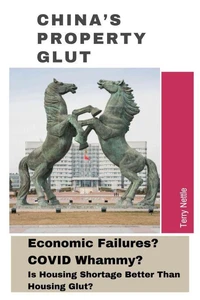Silk Road or War Path: Western Frontiers of Ancient China and Beyond
Par :Formats :
Disponible dans votre compte client Decitre ou Furet du Nord dès validation de votre commande. Le format ePub est :
- Compatible avec une lecture sur My Vivlio (smartphone, tablette, ordinateur)
- Compatible avec une lecture sur liseuses Vivlio
- Pour les liseuses autres que Vivlio, vous devez utiliser le logiciel Adobe Digital Edition. Non compatible avec la lecture sur les liseuses Kindle, Remarkable et Sony
 , qui est-ce ?
, qui est-ce ?Notre partenaire de plateforme de lecture numérique où vous retrouverez l'ensemble de vos ebooks gratuitement
Pour en savoir plus sur nos ebooks, consultez notre aide en ligne ici
- FormatePub
- ISBN978-1-393-47117-2
- EAN9781393471172
- Date de parution09/06/2020
- Protection num.pas de protection
- Infos supplémentairesepub
- ÉditeurRelay Publishing
Résumé
This book examines the long and eventful history of ancient China as it relates to its western frontiers and the famous ancient Silk Road. It looks at how the term "Western Frontiers" or "Western Territories" was first used in the classic "Han Book of History - Western Frontiers", closely associated with the epic travels of Zhang Qian, the Han dynasty diplomat-explorer extraordinaire. This was the region which the ancient Silk Road ran through.
It was a road of trade and prosperity as well as a road for war; with many countries, ethnicity, cultures and religions involved. Looking at the whole breadth of the Silk Road geography, one could see history unfolding in the long stretches of land in west and central Asia; from the shores of the Mediterranean Sea, to Black Sea, to Caspian Sea, to Aral Sea, to Lake Balkhash, and to Lake Baikal. These six bodies of water are the connecting focal points of all the human drama and all the amazing cultural and other exchanges over these regions. And all the human drama along this ancient Silk Road were played out by the many ethnicity and cultures including the Chinese, Mongolic, Turkic, Persian, Mesopotamian, Egyptian, Indian, Greek, Roman and Arabic civilizations.
The book traces all that all these peoples and more had to go through, their remarkable achievements and their follies along the ancient Silk Road. The book then elaborates on the inevitable interactions that all countries have with foreign countries and peoples, and raises the three critical questions that need to be asked by every generation in every country: (1) to befriend or to begone, (2) to trade or to thrash, and (3) to confer or to confront. The past history of endless wars and brutal colonization along the Silk Road and beyond need to be carefully studied for their precious lessons so that humans may build a peaceful and sustainable future for all humanity.
It was a road of trade and prosperity as well as a road for war; with many countries, ethnicity, cultures and religions involved. Looking at the whole breadth of the Silk Road geography, one could see history unfolding in the long stretches of land in west and central Asia; from the shores of the Mediterranean Sea, to Black Sea, to Caspian Sea, to Aral Sea, to Lake Balkhash, and to Lake Baikal. These six bodies of water are the connecting focal points of all the human drama and all the amazing cultural and other exchanges over these regions. And all the human drama along this ancient Silk Road were played out by the many ethnicity and cultures including the Chinese, Mongolic, Turkic, Persian, Mesopotamian, Egyptian, Indian, Greek, Roman and Arabic civilizations.
The book traces all that all these peoples and more had to go through, their remarkable achievements and their follies along the ancient Silk Road. The book then elaborates on the inevitable interactions that all countries have with foreign countries and peoples, and raises the three critical questions that need to be asked by every generation in every country: (1) to befriend or to begone, (2) to trade or to thrash, and (3) to confer or to confront. The past history of endless wars and brutal colonization along the Silk Road and beyond need to be carefully studied for their precious lessons so that humans may build a peaceful and sustainable future for all humanity.
This book examines the long and eventful history of ancient China as it relates to its western frontiers and the famous ancient Silk Road. It looks at how the term "Western Frontiers" or "Western Territories" was first used in the classic "Han Book of History - Western Frontiers", closely associated with the epic travels of Zhang Qian, the Han dynasty diplomat-explorer extraordinaire. This was the region which the ancient Silk Road ran through.
It was a road of trade and prosperity as well as a road for war; with many countries, ethnicity, cultures and religions involved. Looking at the whole breadth of the Silk Road geography, one could see history unfolding in the long stretches of land in west and central Asia; from the shores of the Mediterranean Sea, to Black Sea, to Caspian Sea, to Aral Sea, to Lake Balkhash, and to Lake Baikal. These six bodies of water are the connecting focal points of all the human drama and all the amazing cultural and other exchanges over these regions. And all the human drama along this ancient Silk Road were played out by the many ethnicity and cultures including the Chinese, Mongolic, Turkic, Persian, Mesopotamian, Egyptian, Indian, Greek, Roman and Arabic civilizations.
The book traces all that all these peoples and more had to go through, their remarkable achievements and their follies along the ancient Silk Road. The book then elaborates on the inevitable interactions that all countries have with foreign countries and peoples, and raises the three critical questions that need to be asked by every generation in every country: (1) to befriend or to begone, (2) to trade or to thrash, and (3) to confer or to confront. The past history of endless wars and brutal colonization along the Silk Road and beyond need to be carefully studied for their precious lessons so that humans may build a peaceful and sustainable future for all humanity.
It was a road of trade and prosperity as well as a road for war; with many countries, ethnicity, cultures and religions involved. Looking at the whole breadth of the Silk Road geography, one could see history unfolding in the long stretches of land in west and central Asia; from the shores of the Mediterranean Sea, to Black Sea, to Caspian Sea, to Aral Sea, to Lake Balkhash, and to Lake Baikal. These six bodies of water are the connecting focal points of all the human drama and all the amazing cultural and other exchanges over these regions. And all the human drama along this ancient Silk Road were played out by the many ethnicity and cultures including the Chinese, Mongolic, Turkic, Persian, Mesopotamian, Egyptian, Indian, Greek, Roman and Arabic civilizations.
The book traces all that all these peoples and more had to go through, their remarkable achievements and their follies along the ancient Silk Road. The book then elaborates on the inevitable interactions that all countries have with foreign countries and peoples, and raises the three critical questions that need to be asked by every generation in every country: (1) to befriend or to begone, (2) to trade or to thrash, and (3) to confer or to confront. The past history of endless wars and brutal colonization along the Silk Road and beyond need to be carefully studied for their precious lessons so that humans may build a peaceful and sustainable future for all humanity.





















